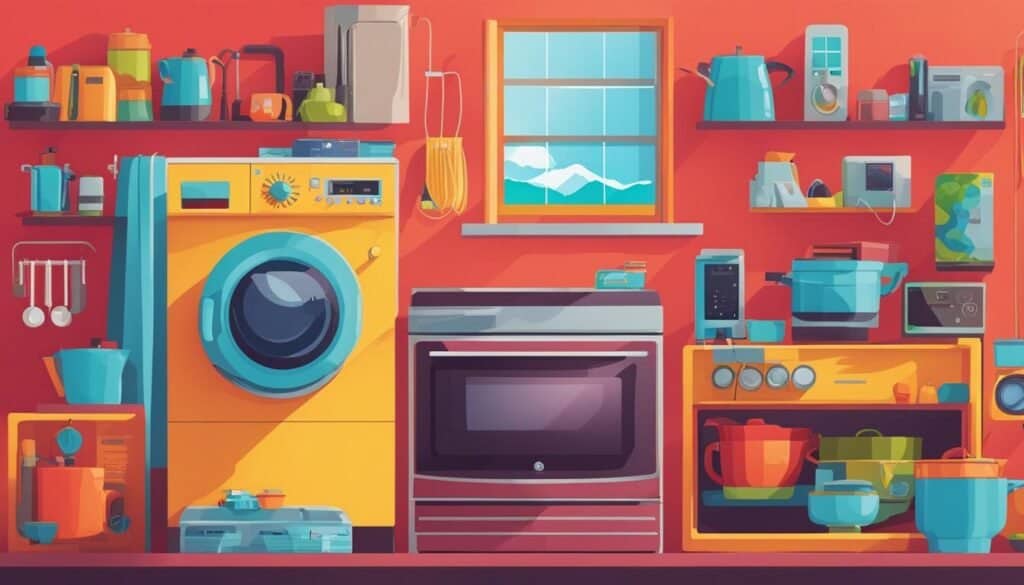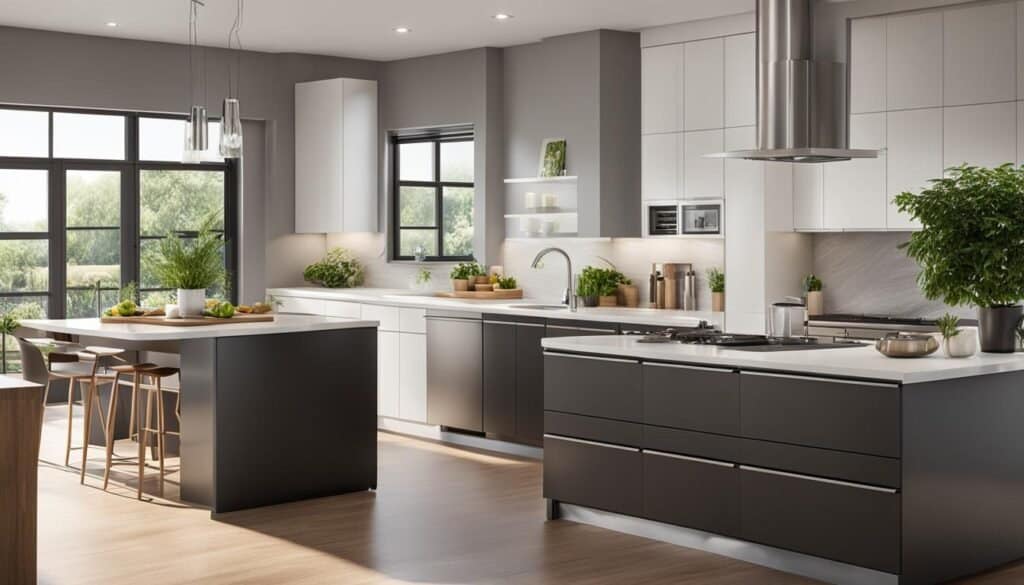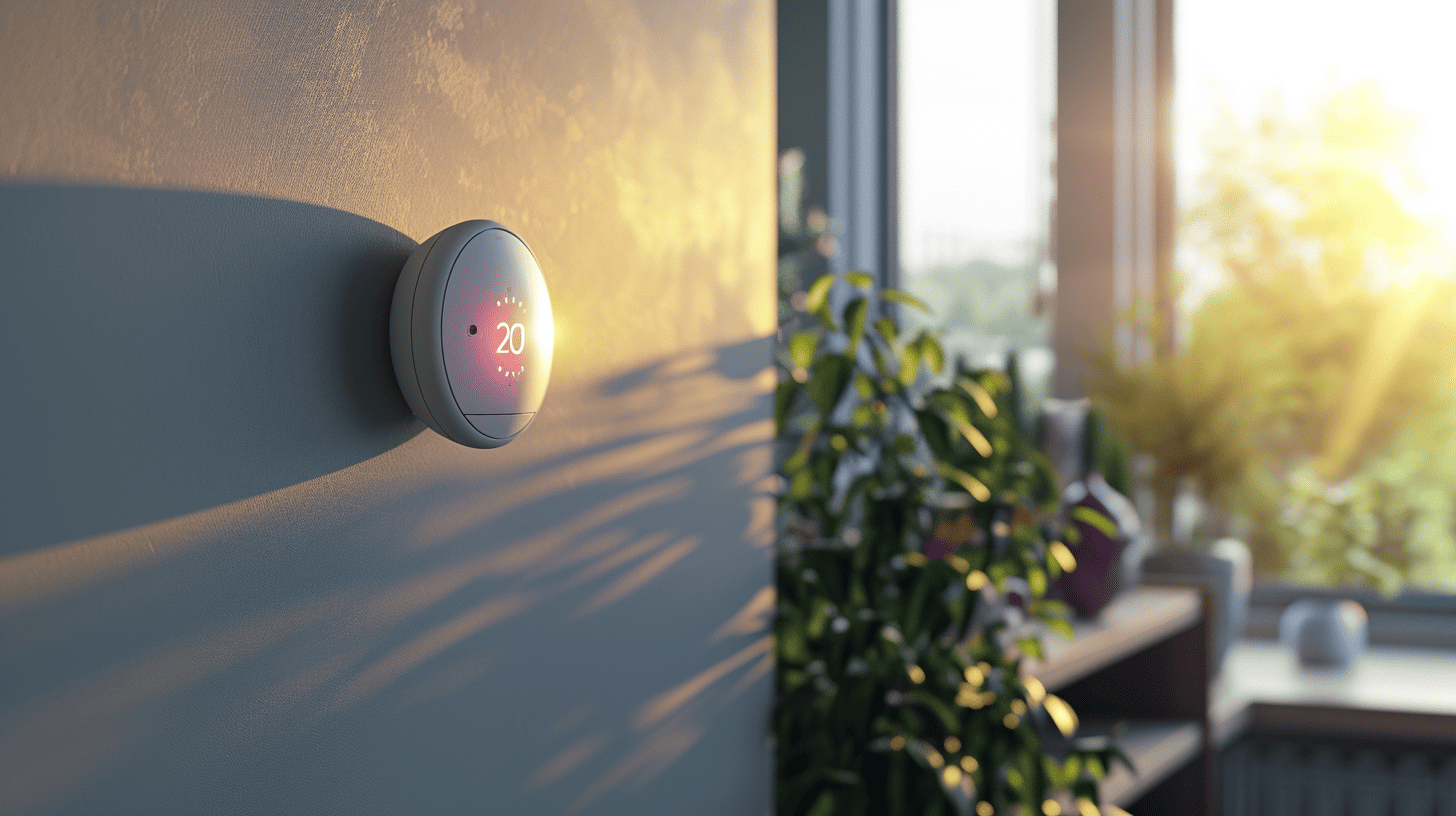As a homeowner, reducing energy consumption not only lowers your bills but also helps contribute to a greener and more eco-friendly lifestyle. From simple habits to smart technology adoption, there are numerous energy-saving tips for homeowners that can result in a more energy-efficient home. This guide will provide you with valuable insights on how to lower energy bills, create an eco-friendly home, and reduce your carbon footprint.
Key Takeaways
- Maximize natural light to reduce reliance on artificial lighting.
- Maintain your air conditioning system for efficient operation.
- Set an energy-efficient thermostat schedule to lower heating and cooling bills.
- Upgrade to Energy Star appliances for better performance and lower electricity usage.
- Implement eco-friendly landscape design to reduce energy consumption.
- Conserve water to save on energy costs related to heating.
- Insulate your home to prevent energy loss and enhance overall efficiency.
11 Energy-Saving Practices for Homeowners
Here are 11 tips for homeowners to save energy at home:
Many of these conservation steps are easy and provide great return on investment through energy savings.
Direct Energy recommends washing your clothes in cold water and using your microwave instead of your stove for cooking to save energy.
Embrace Natural Light and Bright Décor
Maximizing natural light is a simple yet impactful strategy to reduce reliance on artificial lighting and save energy at home. By being mindful of your home’s windows, mirrors, and workspaces, you can brighten your interior without incurring high energy costs.
Maximize Natural Light Through Windows
Start by ensuring the most sunlight enters your home during daylight hours. This can be achieved by:
- Opening curtains and blinds completely to allow sunlight to stream in.
- Cleaning windows regularly to avoid dirt buildup that can obstruct the flow of light.
- Choosing light-colored curtains and blinds that reflect sunlight instead of absorbing it.
By leveraging the sun’s free illumination, you not only conserve energy but can also enhance your mood and wellbeing.
Incorporate Mirrors and Workspaces Near Windows
In addition to focusing on windows, you can also optimize your home’s décor to create a brighter and more energy-efficient environment. Consider the following energy-saving ideas for homeowners:
- Place mirrors near windows to reflect sunlight into the room, amplifying the effect of natural light.
- Arrange workspaces near windows to take advantage of daylight when working or studying.
- Select bright colored furniture, paint, and accessories to create a lighter atmosphere.
These measures optimize interior brightness, minimize the need for electric lighting during daylight hours, and contribute to the energy efficiency of your home.
By embracing natural light and bright décor in your home, you can enjoy an inviting living space that effortlessly conserves energy and lowers your utility expenses.
Maintain Your Air Conditioning System
Proper air conditioning maintenance plays a crucial role in ensuring the efficient operation of your cooling system while also reducing energy costs. To keep your air conditioner in top-notch condition and save on energy bills, follow these simple yet effective maintenance tips:
- Perform regular checks, especially before the summer season, when the AC unit works at its peak.
- Clean air conditioner filters to improve airflow and maximize cooling efficiency.
- Ensure all air vents are unobstructed, allowing for proper air circulation.
Investing in professional ac unit maintenance and taking a proactive approach to care can help prevent costly repairs and prolong the lifespan of your system. Maintenance services will typically include tasks such as:
- Inspecting and cleaning evaporator units.
- Checking and servicing fan motors.
- Inspecting and tightening electrical connections.
- Examining and calibrating thermostat settings.
While it’s essential to clean air conditioner components, paying attention to the outdoor unit is equally important. Ensure the area around the unit is free of debris and plants to maintain optimal airflow and system functionality. This also helps to prevent damage to the unit itself.
By prioritizing air conditioning maintenance, you not only lower your energy bills but also contribute to a healthier, more comfortable living environment during hot summer months.
For a more comprehensive understanding of the benefits of regular air conditioning maintenance, consider the following table detailing the energy efficiency improvements and associated savings:
| Maintenance Task | Energy Efficiency Improvement (%) | Annual Savings ($) |
|---|---|---|
| Replace dirty filters | 5-15 | 40 |
| Seal ducts | 20 | 150 |
| Clean evaporator coils | 5-10 | 75 |
| Clear outdoor unit | up to 5 | 20 |
Maintaining your air conditioning system is a simple step that can lead to significant energy savings and improved indoor air quality. By following these tips, you can enjoy the benefits of a clean, efficient, and long-lasting AC system in your home.
Set an Energy-Efficient Thermostat Schedule
Establishing an energy-efficient thermostat schedule is a significant step in managing your home’s heating and cooling system without sacrificing comfort. By leveraging the benefits of programmable thermostats and smart thermostat options, you can personalize your temperature settings to save on electricity bills and improve energy management in your home.
Invest in Programmable Thermostats
Programmable thermostats are an affordable way to gain control over your home’s heating and cooling settings. These devices allow you to create a customized schedule for adjusting temperature levels according to your routine, such as lowering the temperature when the home is empty or during sleep. This helps to reduce energy usage and consequently save on electricity bills.
“Investing in programmable thermostats allows individuals to customize their energy usage for heating and cooling, achieving noticeable reductions in electricity bills.”
Here are some advantages of owning a programmable thermostat:
- Pre-set temperature adjustments for optimal comfort throughout the day
- Reduced energy consumption during unoccupied hours
- Minimal need for manual temperature changes
- Potential compatibility with smart home automation systems
Department of Energy advises adjusting your thermostat to a lower comfortable setting when you’re awake at home, and turning it back when asleep or out of the house, to save up to 10% a year on heating and cooling bills.
Consider Smart Thermostat Options
Smart thermostat options take temperature control and energy management to the next level. These devices not only offer customizable temperature settings but also use artificial intelligence to learn your preferences and habits over time. By adapting temperature levels for heating and air conditioning based on occupancy and personal preferences, smart thermostats make a noteworthy impact on energy conservation.
“Smart thermostats utilize advanced technology to continuously adapt heating and cooling settings, providing a perfect balance of energy conservation and indoor comfort.”
Below is a comparison of some popular smart thermostat options and their features:
| Smart Thermostat | Learning Capabilities | Geo-fencing | Energy Reports |
|---|---|---|---|
| Nest Learning Thermostat | Yes | Yes | Yes |
| ecobee SmartThermostat | No | Yes | Yes |
| Honeywell Home T9 | No | Yes | No |
By opting for an energy-efficient thermostat schedule with the help of programmable or smart thermostat options, you can maintain a comfortable home environment, conserve energy, and reduce electricity bills.
Optimize Your Home’s Window Efficiency

Ensuring optimal window efficiency is a vital part of conserving energy at home, as well as reducing energy costs. By assessing the need for window upgrades or implementing cost-effective alternatives, homeowners can make significant strides in improving their home’s energy efficiency.
Assess Your Need for Window Upgrades
Modern window technologies can offer both aesthetic and energy-saving benefits. Energy-efficient home improvements that include replacing older windows with newer, more efficient options can result in lower energy consumption and long-term savings. Consider factors such as the age of the windows, the home’s exposure to sunlight, and drafts that suggest inadequate sealing.
If budget constraints prevent a full window upgrade, alternative solutions like blinds and solar screens can provide some advantages. These options can help reduce radiant heat entering the home, ultimately decreasing the strain on cooling systems.
Utilize Window Shades and Block Radiant Heat
Window shades serve as an affordable and effective way to manage and block radiant heat from entering your home. In addition to enhancing the home’s aesthetic aspect, window shades can regulate the interior temperature and contribute to overall energy conservation efforts. Blackout curtains and reflective window films are two popular options for achieving this goal.
By taking advantage of window shades, you are actively reducing the workload on your air conditioning system, thereby conserving energy at home and lowering costs.
Implementing the right mix of window upgrades and alternative solutions can make a significant positive impact on your home’s energy efficiency. Optimize your home’s window efficiency today to enjoy the benefits of a lower energy bill and eco-friendly living.
Leverage Energy Conservation Techniques

Incorporating energy conservation techniques into your daily routine is a straightforward way to reduce electricity bill and conserve energy at home. Developing adaptive habits and making minor adjustments can go a long way in curbing energy consumption and saving money on your utility bills.
- Unplug unused appliances and devices: Standby power consumption, also known as ‘phantom load,’ occurs when devices draw electricity even when they are switched off. Unplugging appliances and electronic devices when not in use helps minimize this wastage.
- Wash clothes in warm or cold water: A majority of the energy utilized in clothes washing is dedicated to heating the water. Opting for warm or cold water instead of hot reduces energy consumption and your carbon footprint.
- Adjust refrigerator temperature: Setting the refrigerator temperature between 35°F and 38°F (2°C to 3°C) and the freezer between 0°F and 5°F (-18°C to -15°C) ensures food stays fresh while using the least amount of energy.
“Small shifts in behavior can have a meaningful impact on your utility bills and energy efficiency at home.”
Besides these habits, here are a few more energy conservation techniques to consider:
- Air dry clothes instead of using a dryer.
- Turn off lights when leaving a room.
- Close doors and windows when heating or cooling rooms.
- Make the most of daylight hours for chores and activities.
| Energy Conservation Technique | Benefits |
|---|---|
| Unplugging appliances | Reduces phantom load and electricity usage |
| Using warm or cold water for washing | Decreases energy consumption and carbon footprint |
| Adjusting refrigerator temperature | Ensures food freshness and lowers energy usage |
| Turning off lights | Conserves electricity and reduces costs |
| Closing doors and windows | Maximizes heating and cooling efficiency |
| Utilizing daylight hours | Minimizes reliance on artificial lighting |
Implementing these energy conservation techniques, alongside thorough mindfulness, can lead to a significant drop in your electricity bills. Cultivating energy-efficient habits encourages sustainable resource use, helping you conserve energy at home and contribute to a greener future.
Upgrade to Energy-Efficient Appliances

Transitioning to energy-efficient appliances marked with the Energy Star label is a significant step in reducing electric bills. These appliances maintain performance while using less energy, making them a wise investment for both monetary savings and environmental impact.
When shopping for new appliances, it can be helpful to understand the benefits and types of energy-efficient appliances available on the market. The following are some popular Energy Star appliances and their energy-saving features:
- Refrigerators
Energy Star certified refrigerators are at least 15% more energy-efficient than the federal minimum energy-efficiency standard.
- Dishwashers
Energy Star dishwashers not only use less energy, but they also consume less water, further contributing to your energy savings.
- Washing Machines
Energy Star washing machines use around 25% less energy and 33% less water compared to non-certified counterparts. Moreover, they are designed to optimize detergent usage and reduce wear on clothes.
- Clothes Dryers
With advanced technologies such as moisture sensors and energy-saving modes, Energy Star certified clothes dryers demonstrate a 20% improvement in energy efficiency.
The advantages of these energy-efficient appliances extend beyond reduced energy consumption to include better performance and time-saving features. Let’s now compare the average annual energy consumption and cost savings associated with some popular Energy Star appliances:
| Appliance Type | Average Annual Energy Consumption (kWh) | Average Annual Cost Savings (USD) |
|---|---|---|
| Refrigerator | 350-600 | 20-70 |
| Dishwasher | 270-300 | 15-25 |
| Washing Machine | 80-110 | 15-40 |
| Clothes Dryer | 600-800 | 30-60 |
In addition to upgrading your appliances, make sure to take advantage of energy-saving modes whenever available. This will maximize the efficiency of your appliances and further contribute to lower energy bills, making your investment worth every penny.
Utilize Smart Home Automation for Energy Savings

With the advancement in technology, smart home automation has become a crucial component in creating an energy-efficient home. By integrating intelligent elements such as motion sensor lights and smart appliances, households can save energy and reduce their overall consumption.
Install Motion Sensor and Smart Lights
Motion sensor lights and smart lights are innovative ways to conserve energy and minimize wastage. These advanced lighting systems only operate when needed, ensuring that you’re not using electricity unnecessarily.
Motion sensor lights are perfect for outdoor spaces, hallways, and rooms where constant lighting is not required, while smart lights can be scheduled and controlled remotely to further refine your energy usage.
Moreover, many smart lights offer energy-efficient LED options, which last longer and consume less power than traditional incandescent bulbs. Implementing smart lighting solutions throughout your home will not only save energy but also contribute to a comfortable living environment.
Opt for Energy-Saving Smart Appliances
When upgrading your home appliances, it’s essential to choose energy-saving smart appliances that contribute to a greener, more efficient household. These appliances often exceed the performance of conventional counterparts and play a significant role in reducing energy consumption. Consider the following energy-efficient solutions for your home:
- Smart power strips: These advanced power strips help minimize standby power consumption by turning off devices when they’re not in use. With built-in features like surge protection and remote control, smart power strips are an essential investment.
- Smart thermostats: A smart thermostat allows you to regulate your home’s temperature efficiently, saving energy and reducing heating and cooling costs. With features like learning algorithms, occupancy sensors, and geofencing, these thermostats adapt to your preferences and occupancy patterns, ensuring optimal energy savings.
- Energy-efficient smart refrigerators: Modern smart refrigerators offer greater energy efficiency than their traditional counterparts. Features such as variable-speed compressors and temperature management ensure optimal cooling while reducing energy consumption.
| Energy-Saving Smart Appliances | Key Features |
|---|---|
| Smart Power Strips | Minimize standby power, surge protection, remote control |
| Smart Thermostats | Learning algorithms, occupancy sensors, geofencing |
| Energy-Efficient Smart Refrigerators | Variable-speed compressors, temperature management |
In conclusion, implementing smart home automation solutions can significantly improve your home’s energy efficiency while creating a comfortable living environment. From motion sensor lights to energy-saving smart appliances, these innovative technologies play a critical role in reducing energy consumption and paving the way for a greener, more sustainable future.
Insulate Your Home to Prevent Energy Loss
Proper home insulation plays a vital role in maintaining an energy-efficient household. By insulating your walls and attic, you can significantly reduce energy costs and prevent energy loss. This section will guide you on how to insulate your home effectively to maximize your energy savings.
Check Insulation in Walls and Attics
One of the primary steps to improve your home’s insulation is to evaluate the condition of your walls and attic. These areas are prone to heat loss during the winter and excessive heat intake during the summer, leading to increased energy costs. Choosing the right insulation material, such as fiberglass, cellulose, or spray foam, is essential to prevent energy loss. To further improve your home’s energy efficiency, consider upgrading your insulation if it’s outdated or damaged. A well-insulated home retains heat in cold weather and keeps it cool in the summer, thereby lowering your energy bills.
Seal Air Leaks with Caulk or Weather Stripping
Air leaks are a common source of energy loss in homes. These gaps and cracks, often found around windows, doors, or electrical outlets, can lead to unwanted drafts and heat loss. Sealing these air leaks using caulk or weather stripping is a simple and cost-effective measure that can substantially enhance your home’s energy efficiency. Here are some simple guidelines to follow:
- Identify air leaks: Inspect your home for any gaps or cracks that may be causing air leakage. Pay close attention to areas around windows, doors, and electrical outlets.
- Choose the right sealing material: Select either caulk or weather stripping, depending on the size and location of the leak. Caulk is best suited for sealing small cracks, while weather stripping is ideal for sealing larger gaps around windows and doors.
- Apply the sealant: Follow the manufacturer’s instructions to apply the chosen sealant properly. Ensure a tight and lasting seal to prevent future energy loss.
In conclusion, insulating your home and sealing air leaks are cost-effective measures for reducing energy consumption and achieving a more energy-efficient house. By implementing these energy-saving solutions, you can significantly lower your energy bills and contribute to a more sustainable way of living.
Conserve Water to Reduce Energy Consumption
Conserving water can play a significant role in reducing your energy consumption and effectively lowering your utility bills. By embracing water conservation habits and adopting low-flow fixtures, homeowners can minimize the amount of energy required for various water-related activities.
One might not realize it, but heating water can contribute to a significant portion of a household’s energy use. Efforts to conserve water and use it more efficiently translate into energy savings as well as a reduced environmental footprint.
Adopt Low-Flow Fixtures and Water Conservation Habits
Low-flow fixtures are designed to use water more efficiently without compromising their performance. These fixtures include faucets, showerheads, and toilets that have been engineered to reduce water flow rates while maintaining satisfactory user experience. By installing these fixtures, a homeowner can conserve both water and energy in the long run.
Adopting water conservation habits can also lead to significant energy savings. A conscious effort to conserve water while performing everyday tasks can greatly reduce the amount of energy consumed during these activities. Examples of practical water conservation habits include:
- Washing clothes in cold or warm water instead of hot water
- Opting for shorter showers or using a water-saving showerhead
- Using a broom instead of a hose to clean driveways and sidewalks
- Watering gardens and lawns during the early morning or evening to minimize evaporation
- Fixing leaks in pipes, toilets, and faucets promptly
- Using a dishwasher only when completely full to optimize water and energy use
By incorporating low-flow fixtures and basic water conservation habits into your daily routine, you contribute towards the reduction of your energy consumption and the overall improvement of your home’s efficiency.
“Saving water equals saving energy. It’s surprising how much energy is hidden in the water we use daily.”
In conclusion, conserving water is an integral part of reducing energy consumption. By embracing water-efficient technologies such as low-flow fixtures and adopting sustainable water conservation habits, homeowners can achieve significant energy savings and contribute to a more eco-friendly lifestyle.
Implement An Eco-Friendly Landscape Design
Creating an eco-friendly landscape design in your outdoor space contributes to energy conservation while enhancing the visual appeal of your home. A well-planned landscape can provide natural cooling effects by featuring strategically-placed shade trees and windbreaks. In addition, incorporating rainwater collection systems can help conserve water and reduce the demand for treated water, cutting down your energy usage at home.
Plan for Shade Trees and Windbreaks
Shade trees and windbreaks are essential components of an eco-friendly landscape design. Planting deciduous shade trees on the south and west sides of your home helps block direct sunlight during the hot summer months, reducing the need for air conditioning. Once the leaves fall in the colder months, they allow sunlight to warm your home, reducing heating demands. Additionally, evergreen windbreaks can be planted on the north and west sides of your property to block cold winter winds, further reducing heating costs.
Choose plants and trees that are native to your region to ensure they thrive and require less maintenance.
Explore Options for Rainwater Collection Systems
Another eco-friendly element of landscape design involves the use of rainwater collection systems. There are various options available for homeowners to capture and store rainwater, such as rain barrels, cisterns, and rain gardens. These systems contribute to water conservation, diminishing the need for pumped and treated water.
- Rain barrels: Positioned under downspouts to collect water from your roof, these barrels store water that can be used for watering plants, gardens, and lawns.
- Cisterns: Larger than rain barrels, cisterns are usually installed underground and can store significant amounts of water, ideal for irrigation or even reuse inside your home.
- Rain gardens: These are shallow, planted depressions designed to capture and filter stormwater runoff from roofs, driveways, and other impervious surfaces. They help reduce flooding and pollution while adding beauty to your yard.
Implementing these eco-friendly home tips in your landscape design can lead to significant energy savings and a more sustainable living environment. By considering shade trees and windbreaks in your garden planning, along with efficient rainwater collection systems, you can effectively conserve energy at home and reduce your environmental footprint.
Conclusion
As a homeowner, you have numerous energy-saving strategies at your disposal to create a sustainable and eco-friendly living environment. With thoughtful planning and action, you can make significant energy savings and contribute to green energy solutions. By following the guidance provided in this article, you’ll be well on your way to achieving a more eco-friendly home.
By taking advantage of natural light, maintaining your air conditioning system, and adopting smart technology throughout your home, you’ll see considerable improvements in your home’s energy efficiency. In addition, insulating your house effectively can further reduce energy consumption, lowering your energy bills in the long run.
With efforts in water conservation, eco-friendly landscape design, and the utilization of Energy Star appliances, you are not only setting an example but also encouraging a greener future for generations to come. Remember, building an eco-friendly home is a process that involves constant improvement and adaptation. By embracing these energy-saving tips, you will make a significant impact on both your wallet and the environment.
FAQ
How can I maximize natural light in my home?
To maximize natural light, open curtains and blinds, arrange workspaces near windows, and incorporate mirrors to reflect light throughout your home.
What can I do to maintain my air conditioning system efficiently?
Regularly clean filters, unobstructed air ventilators, and invest in professional maintenance to keep your air conditioning system running efficiently.
How can programmable thermostats help me save energy?
Programmable thermostats can help you establish energy-efficient schedules by adjusting temperature settings when you are not at home or during sleep, significantly lowering your heating and cooling bills.
What are some ways to optimize my home’s window efficiency?
Assess your need for window upgrades, use window shades, and explore alternative solutions like blinds and solar screens to block radiant heat and optimize window efficiency.
What energy conservation techniques can I use to reduce my electricity bill?
Unplug appliances when not in use, wash clothes in warm or cold water, and turn down the refrigerator temperature to conserve energy and reduce your electricity bill.
How can smart home automation help me save energy?
Smart home automation, such as motion sensor lights and energy-saving smart appliances, can help you manage energy usage intelligently and reduce energy consumption.
How does insulating my home prevent energy loss?
Properly insulating walls and attics minimizes energy loss by retaining heat during winter and keeping spaces cooler during summer, leading to substantial energy savings.
What can I do to conserve water and reduce energy consumption?
Adopt low-flow fixtures, implement water-saving habits like taking shorter showers and washing clothes in cooler water to conserve water and reduce energy consumption.
How can eco-friendly landscape design help me conserve energy?
Implementing an eco-friendly landscape design by planning for shade trees, windbreaks, and exploring rainwater collection systems can result in natural cooling effects for your home and reduce reliance on artificial cooling systems.





Leave a Reply